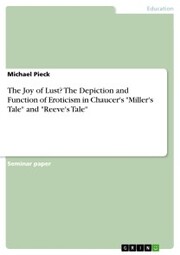Detailansicht
The Joy of Lust? The Depiction and Function of Eroticism in Chaucer's 'Miller's Tale' and 'Reeve's Tale'
eBook
ISBN/EAN: 9783668313637
Umbreit-Nr.: 4246594
Sprache:
Englisch
Umfang: 20 S., 0.98 MB
Format in cm:
Einband:
Keine Angabe
Erschienen am 05.10.2016
Auflage: 1/2016
E-Book
Format: PDF
DRM: Nicht vorhanden
- Zusatztext
- Seminar paper from the year 2010 in the subject Didactics for the subject English - Literature, Works, grade: 1,3, University of Cologne (Englisches Seminar), course: Hauptseminar English Literature from Chaucer to Shakespeare, language: English, abstract: This paper will scrutinize the Millers Tale and the Reeves Tale with regard to their erotic contents and the instances of obscene speech. The main emphasis will be put on a discussion on the genre of the tales as well as the question, whether instances of eroticism are really the light-hearted expression of joyful lust, or rather skillful narrative means serving both the authentic representation of the characters and the emphasizing of the tales overall morals.There is hardly any period in history that has preoccupied people of later eras as much as the Middle Ages. They have been a recurring popular subject in literature over the last two hundred years. The film industry could not go without them. One reason for this fascination might be the fact that the Middle Ages are both a part of our own history, still visible in magnificent church buildings, and an era that lies half a millennium away from us. This distance and a rather limited knowledge about the real circumstances contribute to a hazy image leaving plenty of space for interpretation and imagination. A popular view on the Middle Ages from our perspective is that of jaunty folk, who enjoyed their lives being free of the restraints of our modern society. It is therefore not surprising that the Italian director Pier Paolo Pasolini chose the Canterbury Tales for one of the films in his Trilogy of Life the other two being Bocaccios The Decameron and Arabian Nights. Pasolini made his films in a time which today is referred to as the Sexual Revolution. Perhaps it was the undisguised depiction of sexuality in some of the Canterbury Tales which had inspired him to adapt them for the screen.One of the Canterbury Tales we find in Pasolinis film is the Millers Tale. It is the second story being told, after the Knights Tale, and it forms a unit, or a diptych, together with the Reeves Tale, which follows. One does not have to approve of Pasolinis intentions in order to acknowledge the erotic elements in both of these tales. Having a closer look at the instances of eroticism in the tales leads to the question of the authors motivation to employ them. Are the Millers and the Reeves Tale erotic stories written with the intention to arouse sexual feelings, or were they rather meant to challenge and provoke the contemporary authorities? Was it common literary practice in Chaucers time to use erotic or obscene speech, or did he break new ground in literature?
- Kurztext
- Seminar paper from the year 2010 in the subject English - Literature, Works, grade: 1,3, University of Cologne (Englisches Seminar), course: Hauptseminar English Literature from Chaucer to Shakespeare, language: English, abstract: This paper will scrutinize the Millers Tale and the Reeves Tale with regard to their erotic contents and ...
